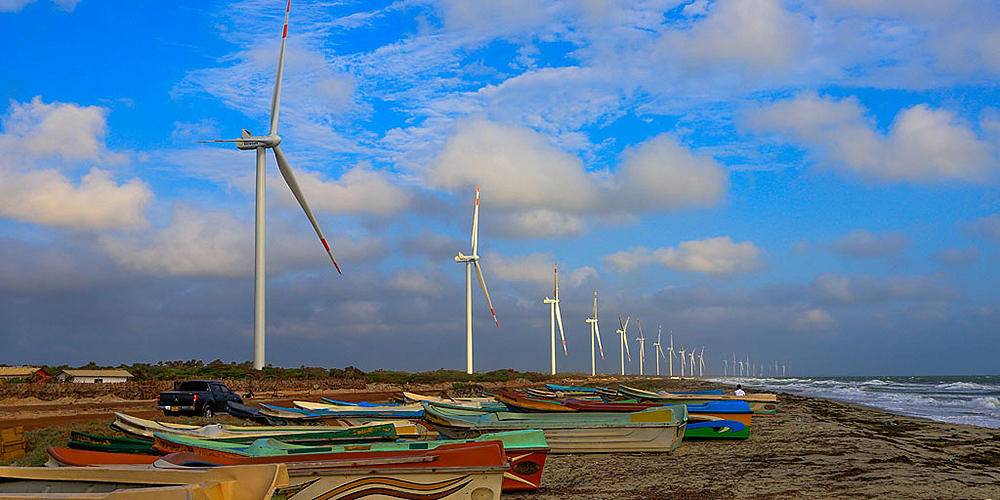September 26, 2023 Reading Time: 2 minutes

Reading Time: 2 min read
Michael Iveson
Research Fellow (Global Economy) at Lakshman Kadirgamar Institute of International Relations and Strategic Studies.
Abstract: Sri Lanka faces an unprecedented economic crisis that threatens to undermine efforts to address climate vulnerabilities. Policymakers and experts have explored the potential of climate finance instruments, such as debt-for-nature and debt-for-climate swaps, to tackle debt and climate vulnerabilities simultaneously. This policy paper proposes a ‘debt-for-renewables’ swap as a type of debt-for-climate swap mechanism to mobilise capital for essential investments in climate-resilient energy infrastructure in Sri Lanka. Servicing external sovereign debt has significant opportunity costs for Sri Lanka’s economic development; policymakers must explore innovative ways to reallocate finance towards more productive sectors and create a more sustainable debt environment. A ‘debt-for-renewables’ swap exists at the intersection of debt, climate and energy sector challenges and has the potential to generate a large multiplier effect that also addresses structural imbalances in the Sri Lankan economy.
ශ්රී ලංකාව පෙර නොවූ විරූ ආර්ථික අර්බුදයකට මුහුණ දී සිටින අතර එය දේශගුණික අවදානම් ආමන්ත්රණය කිරීමේ උත්සාහයන් වලක්වාලීමට තර්ජනය කරයි. ප්රතිපත්ති සම්පාදකයින් සහ ප්රවීණයන්, ණය සහ දේශගුණික අවදානම්වලට සමගාමීව විසඳීමට “ස්වභාවධර්මය සඳහා ණය” සහ “දේශගුණය සඳහා ණය” හුවමාරුව වැනි දේශගුණික මූල්ය උපකරණවල විභවයන් ගවේෂණය කර ඇත. මෙම ප්රතිපත්ති අධ්යනය මගින් ශ්රී ලංකාවේ දේශගුණයට ඔරොත්තු දෙන බලශක්ති යටිතල පහසුකම් සඳහා අත්යවශ්ය ආයෝජන සඳහා ප්රාග්ධනය බලමුලු ගැන්වීමට දේශගුණික හුවමාරු යාන්ත්රණයක් ලෙස ‘පුනර්ජනනය සඳහා ණය’ හුවමාරුවක් යෝජනා කරයි. බාහිර ස්වෛරී ණයට සේවා සැපයීම ශ්රී ලංකාවේ ආර්ථික සංවර්ධනය සඳහා සැලකිය යුතු අවස්ථා පිරිවැයක් දරයි; ප්රතිපත්ති සම්පාදකයින් වඩාත් ඵලදායි අංශ වෙත මූල්ය ප්රතිස්ථාපනය කිරීමට සහ වඩාත් තිරසාර ණය පරිසරයක් නිර්මාණය කිරීමට නව්ය ක්රම ගවේෂණය කළ යුතුය. ණය, දේශගුණය සහ බලශක්ති ක්ෂේත්ර අභියෝග ඡේදනය වීමේදී ‘පුනර්ජනනය සඳහා ණය’ හුවමාරුව, ශ්රී ලංකා ආර්ථිකයේ ව්යුහාත්මක අසමතුලිතතාවයන්ටද විසඳුම් සපයමින් විශාල බලපෑමක් ජනනය කිරීමේ හැකියාව ඇත.
காலநிலை பாதிப்புகளை நிவர்த்தி செய்வதற்கான முயற்சிகளை குறைமதிப்பிற்கு உட்படுத்த அச்சுறுத்தும் முன்னோடியில்லாத பொருளாதார நெருக்கடியை இலங்கை எதிர்கொள்கிறது. கொள்கை வகுப்பாளர்கள் மற்றும் வல்லுநர்கள் கடன் மற்றும் காலநிலை பாதிப்புகளை ஒரே நேரத்தில் சமாளிக்க, இயற்கைக்கான கடன் மற்றும் காலநிலைக்கான கடன் பரிமாற்றம் போன்ற காலநிலை நிதிக் கருவிகளின் திறனை ஆராய்ந்துள்ளனர். இந்தக் கொள்கைப் பத்திரம் இலங்கையில் காலநிலைக்கு ஏற்ற ஆற்றல் உள்கட்டமைப்பில் அத்தியாவசிய முதலீடுகளுக்கு மூலதனத்தைத் திரட்டுவதற்கான ஒரு வகை கடனுக்கான காலநிலை பரிமாற்ற பொறிமுறையாக ‘புதுப்பிக்கத்தக்கவைகளுக்கான கடன்’ பரிமாற்றத்தை முன்மொழிகிறது. வெளிநாட்டு இறையாண்மைக் கடனுக்கு சேவை செய்வது இலங்கையின் பொருளாதார வளர்ச்சிக்கு குறிப்பிடத்தக்க வாய்ப்புச் செலவுகளைக் கொண்டுள்ளது; கொள்கை வகுப்பாளர்கள் அதிக உற்பத்தித் துறைகளுக்கு நிதியை மறுஒதுக்கீடு செய்வதற்கும் மேலும் நிலையான கடன் சூழலை உருவாக்குவதற்கும் புதுமையான வழிகளை ஆராய வேண்டும். கடன், காலநிலை மற்றும் எரிசக்தி துறை சவால்களின் குறுக்குவெட்டில் ஒரு ‘புதுப்பிக்கத்தக்க கடன்’ பரிமாற்றம் உள்ளது மற்றும் இலங்கைப் பொருளாதாரத்தில் உள்ள கட்டமைப்பு ஏற்றத்தாழ்வுகளை நிவர்த்தி செய்யும் ஒரு பெரிய பெருக்கி விளைவை உருவாக்கும் ஆற்றலைக் கொண்டுள்ளது.